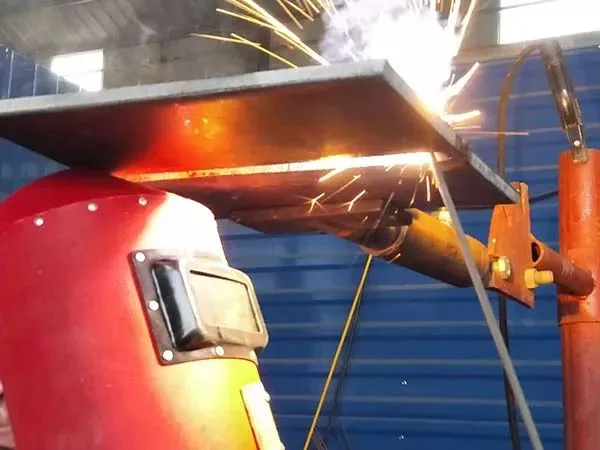Welding method - overhead welding
Overhead welding is welding in which the welding position is below the horizontal level. Overhead welding is the most difficult of the four basic welding positions. Since the molten pool is located below the weldment, the gravity of the molten metal in the electrode will hinder the excessive molten metal, and the molten metal in the molten pool will also fall under its own gravity. The larger the molten pool volume and the higher the temperature, the smaller the expansion force on the surface of the molten pool. Therefore, during overhead welding, it is easy to produce depressions on the back of the weld, and weld nodules will appear on the front weld, making it difficult to form the weld.
Overhead welding is a special position welding method that consumes the most physical energy and is the most difficult, as shown in the figure below.

1. During overhead welding, the molten pool is suspended upside down below the weldment, making it difficult to form the weld, and it is easy to produce weld nodules on the weld surface and collapse on the back. It is also easy to have incomplete penetration and arc pit depression defects.
2. The molten pool size is large, the temperature is high, and it is difficult to remove slag, and sometimes it is easy to produce interlayer slag inclusions.
1. When welding overhead, you must pay attention to maintaining the correct operating posture. The welding point should not be directly above the person, but should be above and forward, and the weld should be biased to the right side of the operator. The electrode clamping method for overhead welding is the same as that for vertical welding.
2. Use small diameter electrodes and small currents for welding. Generally, the welding current for overhead welding is between the welding current for flat welding and the welding current for vertical welding.
3. Use short arc welding to facilitate the transition of molten droplets.
4. Maintain the appropriate electrode angle and the correct electrode feeding method. For overhead butt welding without beveling, it is advisable to use linear electrode feeding when the gap is small, and reciprocating linear electrode feeding when the gap is large. When multi-layer welding is used for overhead butt welding with bevel, the first layer of weld seam should use linear or linear reciprocating electrode feeding methods according to the size of the bevel gap. The remaining layers should use crescent or zigzag electrode feeding methods. Multi-layer
multi-pass welding should use linear electrode feeding. For T-shaped joints with smaller weld leg sizes, single-layer welding is used, and linear electrode feeding methods are used. When the weld leg size is larger, multi-layer welding or multi-layer multi-pass welding is used. The first layer should use linear electrode feeding, and the remaining layers can use oblique ring or triangle electrode feeding methods.
5. When the temperature of the molten pool is too high, the arc can be slightly lifted to slightly reduce the temperature of the molten pool.
6. During overhead welding, due to the gravity of the welding gun and cable, the operator is prone to unstable gun holding, so sometimes it is necessary to hold the gun with both hands for welding.
7. When using the oblique circle to transport the electrode, the electrode head should be consciously pointed to the upper plate first, so that the molten droplet will fuse with the upper plate first. Due to the action of the electrode transport, part of the molten metal will naturally be dragged to the vertical steel plate, so that both sides can be evenly fused.
-
What is a medium-frequency pulse? What types of welding are suitable for?新闻Nov.24,2025
-
Why is the overall cost of CO2 welding lower than that of shielded metal arc welding?新闻Nov.21,2025
-
Welding Knowledge 6新闻Nov.20,2025
-
What is a low-frequency pulse? What types of welding are they suitable for?新闻Nov.19,2025
-
Why are the weld joints from CO₂ gas shielded welding of such high quality?新闻Nov.18,2025
-
J506 Welding Rod - Low Hydrogen, All-Position, AC/DC E7016新闻Nov.17,2025


